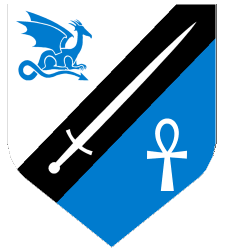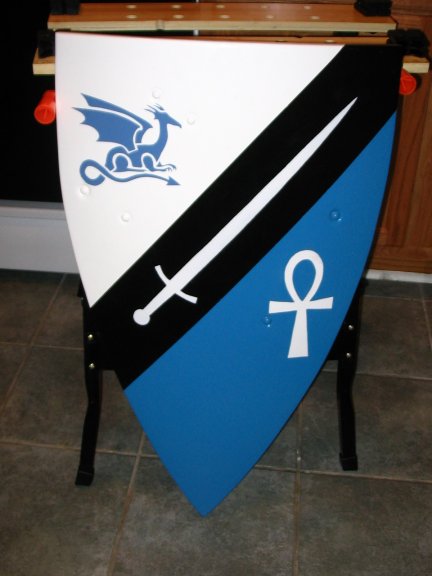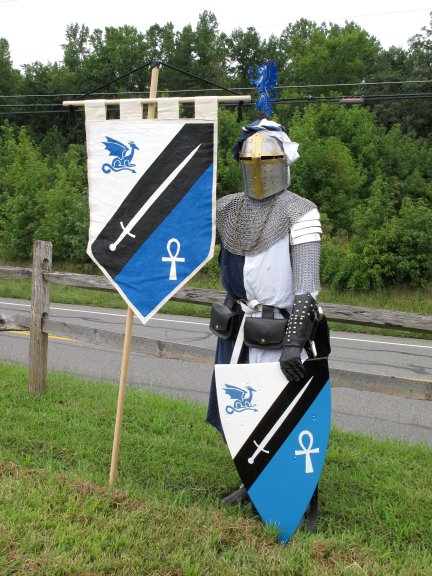|
Ed's CoA
[Back to Essays]
(Last revised: December 21, 2008)
Coat of Arms (my heraldic device)
| |

| |
My CoA |
|
Per bend sinister argent and azure, on a bend sinister sable between a dragon couchant contourny azure and an ankh, a sword argent.
|
|
| |
Over several years I had dabbled with the idea of making a CoA for myself,
but could never settle on something. Late in 2007 I decided that I really
need to get this resolved, since I wanted to work towards having matching
surcoat, shield, and crest. So with the help of my lovely girlfriend, we
sat down and drew up 40 shield designs. Over a few weeks I narrowed it to
5 remaining choices, but couldn't seem to choose further. Then, in a flash
of insight, I modified one of them into the form I now use.
Initially I blazoned it as:
Per bend sinister argent and azure, a dragon couchant to sinister azure, a crux ansata argent, on a bend sinister sable a sword argent.
However, the SCA prefered this blazon (approved January 2009):
Per bend sinister argent and azure, on a bend sinister sable between a dragon couchant contourny azure and an ankh, a sword argent.
Here are the meanings of the individual components:
Colors:
- Argent (silver/white) represents Peace and Sincerity.
- Azure (blue) stands for Truth and Loyalty.
- Sable (black) is for Constancy (not grief in this case).
Devices/Charges/Divisions/Ordinairies/etc:
- Dragon - Valour and Protection. (Personally, also acknowledging and honoring my fantasy gaming and other interests that helped push me towards where I am today)
- Crux Ansata (Ankh, or Cross with Handle) - long life, eternal life, or virtuous life. (Personally, also a promise of leading a chivalrous/virtuous life, and acknowledgment of how that promise has saved me)
- Sword - Justice and Honour. (Personally, also represents my interest in swords and armaments, and personal growth and mental fortitude that was hard earned)
- Bend - Shield suspender of a knight commander; signifies defense and protection.
I must note on some of the meanings and authenticity of some of these items.
The crux ansata, as far as I can tell, was not used in medieval heraldry.
However, as it was used by early Christians as a transitional symbol between the
Ichthys and the modern cross, and continued to be a Christian symbol well into the medieval
period, I don't think it's a stretch to use it. It also has modern (twentieth century)
precedent, being used in official arms recently in various countries.
The following excerpt describes the ankh with regards to Christianity:
The long-standing importance of the Ankh, and its deep symbolism to the dynastic Egyptians, led to it being gradually adopted by the very early Christian church in Egypt (which eventually became the Coptic Church). This is highly significant, as it is almost certainly the genesis of the cross, as the central thematic symbol of the Christian religion. It was non-anthropormorphic, not even animal-like. The gods had all been animal faced-human figures. Anknaton's benevolent sun was the only other symbol that was so esoteric. The cross implied all the "god ideas" that are very infinite in nature. As monotheism is at the core of Christian belief, the ankh seemed a good choice to symbolize the belief in one all-powerful God. Over time, the idea that his son had died on a kind of cross, made it seem all the more appropriate. To other Christians, outside of the ankh's influence, the image the Roman cross of execution was 'shameful" in the manner that a hanging noose would be, or headsman's ax. The association in Egypt of the ankh cross, with both God the Father, and Jesus the Son, felt right. Elsewhere, the main Christian symbol at the time had been a stylised alpha, resembling a fish, and therefore known as Ichthys, the Greek word for fish. However, the new "more positive" symbol of a cross eventually spread throughout the Christianized Empire. The distinct circular or "gothic arch-like" upper part of the Ankh was kept well into mediaeval times. The Ankh symbol was often used as a Christian talisman.
-- The ankh and the cross at www.chaosangel.com
The bend sinister also requires some clarification.
There is no extra meaning to the term "sinister" in this context; it only means that
the object faces to the left (on a shield, the bearer's left) instead of the right.
There has been some
confusion relating this to a representation of illegitimacy. This is a modern
myth, as outlined in the excerpt below:
The Bend-Sinister (Barre) differs from the Bend only by its position.
It runs from the sinister chief to the dexter base. Examples of its
use formerly existed in Britain; but in most cases the charge has come to be
turned into the Bend (dexter) from an idea that in its original form it
suggested illegitimacy. This is a popular error. No such association
originally attached to it, and in many countries non such attaches to it still.
The BENEGNI of Rome bear: Argent, a bend-sinister sable. Argent, a bend-sinister
gules were the original arms of BISSET; they are those of the Barons HASENBERG, etc.
Azure, a bend-sinsiter embattled or is the coat of RONCHIVECCHI, in Tuscany.
Ermine, a bend-sinister gules (d'Hermine, a la barre de gueles) were the
canting arms of BARRE in France. Gules, a bend-sinister argent, are the arms
of RAUCH in Wurttemburg. Or, a bend-wavy sinister purpure, is the coat of KOCH;
and Gules, a bend-sinister or, is a modern grant to RENVERS, of Austria.
To this list large additions might be made, but these are quite sufficient to prove
that the use of the bend-sinister has no necessary connection with illegitimacy
or dishonour.
-- A Treatise on Heraldry, British and Foreign: With English and French Glossaries, page 144
By John Woodward, Published 1896, by W. & A. K. Johnston
Also after this excerpt is a commentary that in some churches it was customary to have the
effigies all face the altar, and therefore it was routine to reverse the arms
on as many as fifty percent of them.
A shorter bendlet sinister, not touching the edges, was occasionally used to
represent an illegitimate child, but not consistently, and this has lead to widespread
belief that it was common for all types of bend sinister.
| |

| |
My Shield |
|
|

| |
My kit |
|
| |
|